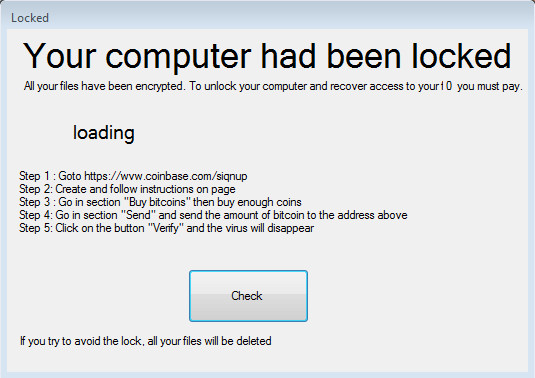RANSOM_LELEOCK.A
Trojan-Ransom.Win32.Blocker.jyhe(Kaspersky); Ransom:Win32/FileCryptor(Microsoft);W32/Blocker.FM!tr(Fortinet)
Windows


Threat Type: Ransomware
Destructiveness: No
Encrypted: No
In the wild: Yes
OVERVIEW
Dropped by other malware, Downloaded from the Internet
This Ransomware arrives on a system as a file dropped by other malware or as a file downloaded unknowingly by users when visiting malicious sites.
It connects to certain websites to send and receive information.
TECHNICAL DETAILS
224,768 bytes
EXE
No
22 Mar 2017
Connects to URLs/IPs, Renames files, Encrypts files
Arrival Details
This Ransomware arrives on a system as a file dropped by other malware or as a file downloaded unknowingly by users when visiting malicious sites.
Installation
This Ransomware drops the following copies of itself into the affected system:
- %Application Data%\rnsm.exe
(Note: %Application Data% is the Application Data folder, where it usually is C:\Documents and Settings\{user name}\Application Data on Windows 2000, Windows Server 2003, and Windows XP (32- and 64-bit); C:\Users\{user name}\AppData\Roaming on Windows Vista (32- and 64-bit), Windows 7 (32- and 64-bit), Windows 8 (32- and 64-bit), Windows 8.1 (32- and 64-bit), Windows Server 2008, and Windows Server 2012.)
It drops the following files:
- %User Temp%\downloadedfrommars.exe
(Note: %User Temp% is the user's temporary folder, where it usually is C:\Documents and Settings\{user name}\Local Settings\Temp on Windows 2000, Windows Server 2003, and Windows XP (32- and 64-bit); C:\Users\{user name}\AppData\Local\Temp on Windows Vista (32- and 64-bit), Windows 7 (32- and 64-bit), Windows 8 (32- and 64-bit), Windows 8.1 (32- and 64-bit), Windows Server 2008, and Windows Server 2012.)
It creates the following folders:
- %Application Data%\rnsm_tor ← contains tor components
(Note: %Application Data% is the Application Data folder, where it usually is C:\Documents and Settings\{user name}\Application Data on Windows 2000, Windows Server 2003, and Windows XP (32- and 64-bit); C:\Users\{user name}\AppData\Roaming on Windows Vista (32- and 64-bit), Windows 7 (32- and 64-bit), Windows 8 (32- and 64-bit), Windows 8.1 (32- and 64-bit), Windows Server 2008, and Windows Server 2012.)
Autostart Technique
This Ransomware adds the following registry entries to enable its automatic execution at every system startup:
HKEY_CURRENT_USER\Software\Microsoft\
Windows\CurrentVersion\Run
rnsm = %Application Data%\rnsm.exe
Process Termination
This Ransomware terminates the following processes if found running in the affected system's memory:
- Processhacker
- Taskmgr
- Wireshark
- Chrome
- Firefox
- Skype
Other Details
This Ransomware connects to the following website to send and receive information:
- http://{BLOCKED}igdpgxxlsg.onion?action=contact&pcid={pcid}&username={username}&os={operating system}&country={country}&build=vajL
It renames encrypted files using the following names:
- {Original File Name and Extension}.lelele
It does the following:
- Displays the following window:


- Encrypts files in %System Root%\Users directory and its subdirectories
- Execute the following command to terminate explorer.exe: taskkill.exe /F /IM explorer.exe
SOLUTION
9.850
13.294.08
23 Mar 2017
13.295.00
24 Mar 2017
Step 1
Before doing any scans, Windows XP, Windows Vista, and Windows 7 users must disable System Restore to allow full scanning of their computers.
Step 2
Note that not all files, folders, and registry keys and entries are installed on your computer during this malware's/spyware's/grayware's execution. This may be due to incomplete installation or other operating system conditions. If you do not find the same files/folders/registry information, please proceed to the next step.
Step 3
Restart in Safe Mode
Step 4
Delete this registry value
Important: Editing the Windows Registry incorrectly can lead to irreversible system malfunction. Please do this step only if you know how or you can ask assistance from your system administrator. Else, check this Microsoft article first before modifying your computer's registry.
- In HKEY_CURRENT_USER\Software\Microsoft\Windows\CurrentVersion\Run
- rnsm = %Application Data%\rnsm.exe
- rnsm = %Application Data%\rnsm.exe
Step 5
Search and delete these folders
- %Application Data%\rnsm_tor
Step 6
Search and delete this file
- %User Temp%\downloadedfrommars.exe
Step 7
Restart in normal mode and scan your computer with your Trend Micro product for files detected as RANSOM_LELEOCK.A. If the detected files have already been cleaned, deleted, or quarantined by your Trend Micro product, no further step is required. You may opt to simply delete the quarantined files. Please check this Knowledge Base page for more information.
Step 8
Restore encrypted files from backup.
Did this description help? Tell us how we did.

